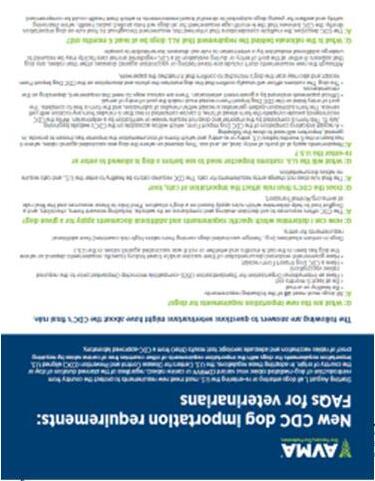
New and Recently Updated CDC Dog Import Regulations
Effective August 1, 2024 Dr. Gail Golab
Associate EVP and Chief Veterinary Officer
ED Town Hall, July 31, 2024



Effective August 1, 2024 Dr. Gail Golab
Associate EVP and Chief Veterinary Officer
ED Town Hall, July 31, 2024

•Prevent re-introduction of dog rabies into United States (declared dog rabies free in 2007).
•Address challenges with international dog importations, including:
•Fraudulent documentation (52% incident increase in 2020 compared with 2018/2019; additional 24% increase first half of 2021).
•False rabies vaccination certificates.
•“Flight parents” importing dogs for resale or adoption, but claiming ownership to avoid USDA Animal Welfare Act regulations and tariffs/fees under US Customs and Border Protection regulations.
•Dogs being transported through dog rabies-free or low-risk countries after being in a high-risk country.
•Dogs housed and transported under unsafe conditions.
•Align with the World Organization for Animal Health’s (WOAH, formerly OIE) standards for the international movement of dogs including:
•Clear and consistent identification.
•Minimum age for movement.
•Titers or quarantine for dogs moving from dog rabies-endemic areas.
•New rule followed temporary suspension of dog imports from high-risk dog rabies countries.
•Standardized forms.
•Network of animal care facilities authorized by CDC to allow for immediate quarantine.
© Copyright 2024. American Veterinary Medical Association. All rights reserved.

•Simplified process.
•Importing dogs that have only been in dog rabies-free or low-risk countries for the past six months now will only require completion of a CDC Dog Import Form.
•Completed by the importer, not the veterinarian.
•Online.
•Takes only a few minutes to complete and response within about 15 minutes.
•CDC indicates will continue for 9 months, until April 30, 2025, while CDC works with industry partners, affected countries, and dog owners to evaluate longer-term approaches.

•Valid for onedog from dog rabies-free or low-risk countries to enter the US multiple times within 6 months from the date of issue.
•Four sections, containing information about:
•Person importing the animal (e.g., dog owner, shipper, “flight parent”, any other person bringing a dog into the US).
•Animal (dog name and description, purpose of importation).
•Travel (type of transport, country of departure, arrival date).
•Signature.
•Form is submitted electronically and a receipt is generated.
•Receipt can be printed or shown on a phone screen to US customs officials or airlines (if applicable).
•Also used for dogs entering from or having been in a high-risk country within past 6 months, but different information and additional documentation beyond the form is required, and the form is only good for one entry.
•There is no fee.
CDC Dog Import Form is available at:
https://cdc786687.workflowcloud.com/for ms/090dc543-7b2f-4538-b2c72919d12ecc73
Instructions for completing the form can be found here: https://www.cdc.gov/importation /dogs/dog-import-forminstructions.html#cdc_generic_ section_2-dogs-coming-fromdog-rabies-free-or-low-riskcountries

•Check this webpage to see if the country qualifies (only high-risk countries are listed, if a country is not listed, it is considered dog rabies-free or low-risk): https://www.cdc.gov/importation/dogs/high-risk-countries.html
•Receipt for a properly completed CDC Dog Import Form (for each dog).
•Dog must be at least 6 months old at time of entry or return to the US.
•Dog must appear healthy upon arrival.
•Dog must have a microchip that can be detected with a universal scanner.
•If a country from which the dog is arriving or where it has been within the past 6 months is not listed as high-risk, a rabies vaccination is not required, but is strongly recommended.
•Dog can enter the US at any airport, seaport or land border crossing.


•Receipt for a properly completed CDC Dog Import Form.
• Certification of US-issued Rabies Vaccination Form or a USDA-endorsed export health certificate. These forms are completed by a USDA-accredited veterinarian before the dog leaves the US and are endorsed by USDA.
•For a dog’s first rabies vaccination the Certification of US-issued Rabies Vaccination Form must be completed no sooner than 28 days after the vaccination was administered.
•If USDA-endorsed export health certificate is used it must include the dog’s age, microchip number, and valid rabies vaccine administered in the US. Use of the export health certificate is an option until July 31, 2025.
• Note rabies vaccination must be valid (not expired) on the date of return.
•Dog must be at least 6 months old at time of entry to the US.
•Dog must appear healthy upon arrival.
•Dog must have a microchip that was implanted before the rabies vaccination was administered and that can be detected by a universal scanner (rabies vaccines administered before the microchip was implanted will not be considered valid).
•Dog’s microchip number must be included on all forms and supporting documents.
•Properly documented dogs can be imported at any airport, seaport, or land border crossing, so long as the port matches the information on the CDC Dog Import Form receipt
© Copyright 2024. American Veterinary Medical Association. All rights reserved.

•A CDC Dog Import Form receipt
•A Certification of Foreign Rabies Vaccination and Microchip Form. This form is completed by the veterinarian in the country where the vaccine is given and endorsed by an official government veterinarian.
•If the above form does not include it, a valid rabies serology titer report from a CDC-approved laboratory.
•A reservation at a CDC-registered animal care facility. If there is no valid rabies serology titer, this must include a 28-day quarantine reservation. A list of facilities is available on the CDC website here: https://www.cdc.gov/importation/dogs/approved-care-facilities.html
•A microchip that can be detected with a universal scanner. The microchip must be implanted before the rabies vaccine is given or the vaccine will be invalid. The microchip number must be included on all forms and supporting documents.
•Dog must be at least 6 months old at the time of entry to the US.
•Dog must appear healthy upon arrival.
•Dog can only enter the US at an airport with a CDC-registered animal care facility.

•CDC has compiled the documents that veterinarians will be required to complete, together with instructions for completing them, for dogs being imported after having been in a high-risk country during the past 6 months here: https://www.cdc.gov/importation/hcp/dog-importation/index.html
•Which form needs to be completed depends on where the dog was vaccinated against rabies (US or another country)
•A list of CDC-approved rabies serology laboratories and instructions for drawing samples are also on this page. A “passing” titer is one that is ≥ 0.5 IU/mL.
•Currently, there are no documents that veterinarians need to complete to support the import of a dog from a dog rabies-free or low-risk country. The importing person completes the CDC Dog Import Form and obtains the receipt.


•These are CDC requirements that come from that agency’s authority for protection of public health.
•USDA is granted authority for protection of animal health and welfare and, under that authority, also has requirements for importation of dogs.
•Disease-related: screwworm, foot-and-mouth disease, tapeworms (dogs used in livestock handling)
•Welfare-related: dogs imported for transfer of ownership (sale, adoption)
•More information is available here: https://www.aphis.usda.gov/pet-travel/another-countryto-us-import/dogs
•Requirements for domestic movement are set by the receiving state or territory.
•Airlines may also have requirements, including for rabies vaccination.



© Copyright 2024. American Veterinary Medical Association. All rights reserved.

•There are no CDC vaccination requirements for cats.
•Cats are susceptible to rabies and CDC recommends all cats be vaccinated against this disease.
•Some US states/territories/districts also have rabies vaccination requirements for cats.
•Airlines may also have requirements.
•Cats that arrive ill at import will be required to undergo veterinary examination and testing to rule outdiseases of public health concern at the importer’s expense.
•Cats that arrive dead at import are required to undergo necropsy and testing to rule out zoonotic disease of public health concern at the importer’s expense.


•CDC believes the 6-month age requirement will help protect public health, while improving safety and welfare for young dogs subjected to stressful travel environments.
•USDA already prohibits importation of dogs younger than 6 months for commercial purposes, which includes transfer of ownership through sale or adoption.
•A 6-month age requirement aligns more closely with WOAH standards for the international movement of dogs, with 67% of rabies-free countries requiring dogs to be at least 6 months of age for importation.
•With respect to dogs arriving from high-risk countries, this age requirement ensures:
•Dogs are old enough to be vaccinated against rabies (minimum of 12 weeks).
•Vaccination has time to confer effective immunity to the dog (28 days after vaccination).
•Protection against rabies can be verified (ensures that time between titer collection and travel is sufficient).
•Easier to more accurately estimate the age of dogs based on their dentition.
•CDC also applies the age requirement to dog rabies-free and low-risk countries because it has documented cases of importers moving dogs too young to be vaccinated effectively from countries with a high risk of dog rabies to low-risk countries to avoid vaccination requirements.

•Ongoing conversation with CDC, including when they implemented their temporary suspension of dog imports from high-risk countries.
•Notifications to leadership and membership when CDC final rule published (multiple vehicles).
•Responses to questions from members, non-members, industry stakeholders, media, public; assistance from CDC when answers not clear from published information.
•AVMA FAQ document addressing commonly asked questions (beyond those responded to by CDC in its own FAQ document).
•CE sessions at AVMA Convention presented by CDC staff.
•Shared information about CDC-offered webinar for veterinarians with membership, including availability of recording and slides from that webinar.
•Notification of recent CDC update to leadership and membership, update of FAQ document.
•Ongoing conversation with veterinary associations, including state VMAs, Canadian VMA, Canadian provincial VMAs
© Copyright 2024. American Veterinary Medical Association. All rights reserved.








